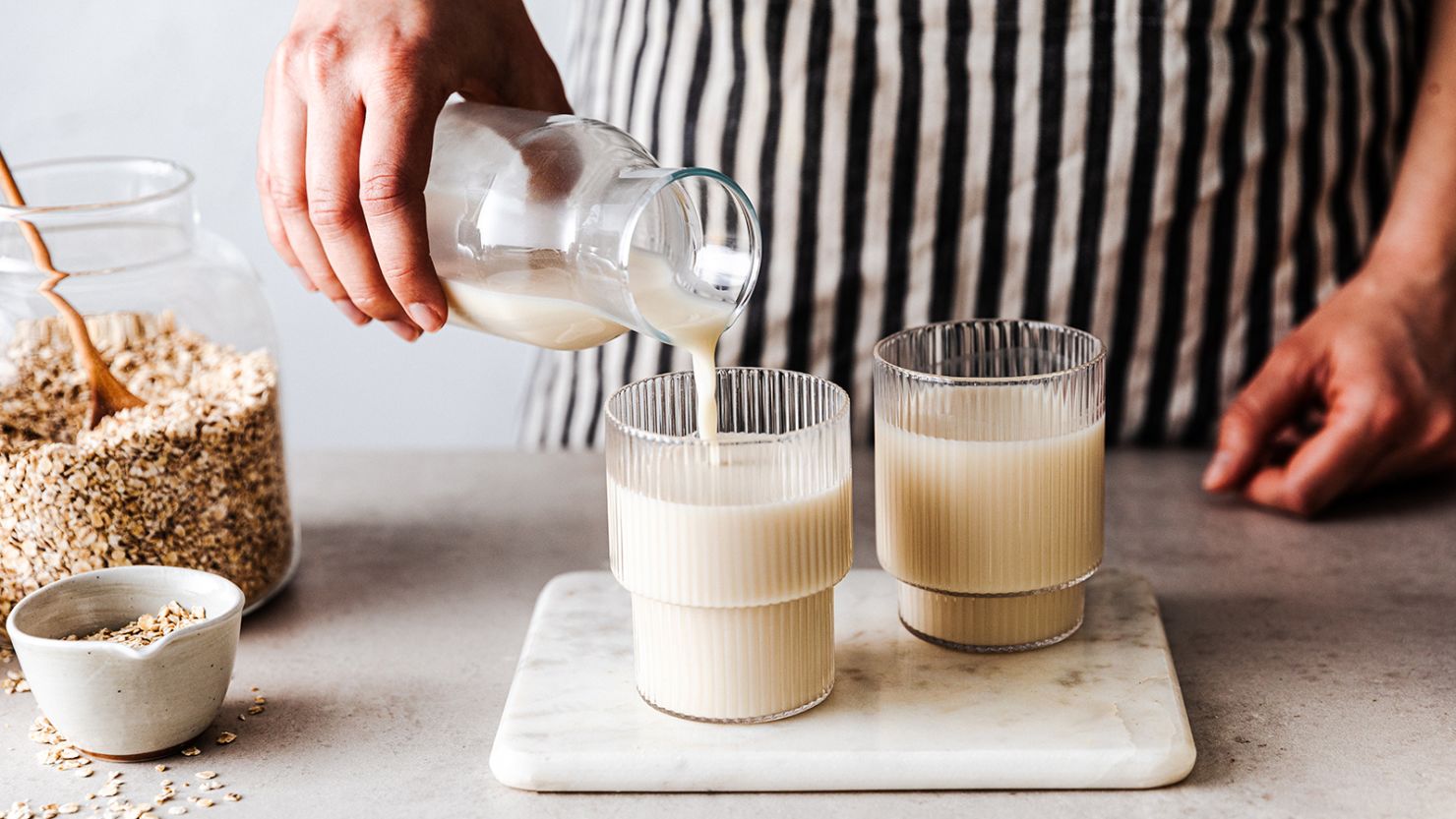Editor’s Note: Sign up for CNN’s Life, But Greener newsletter. Our limited newsletter series guides you on how to minimize your personal role in the climate crisis — and reduce your eco-anxiety.
When it comes to which milk is better for the planet — dairy or plant-based — environmentalists will say there’s no dispute: Milk made from plants wins every time.
Advances in top dairy-producing countries such as China, Italy, New Zealand and the United States have dramatically increased modern milk output per cow — one US cow now makes four times as much milk as a cow in India — while lowering the animal’s environmental impact. There’s even a cow in Wisconsin, named Selz-Pralle Aftershock 3918, which holds the world record for milk production by a Holstein: 78,170 pounds of milk in 365 days.
Yet worldwide demands on natural resources to feed and water dairy cows remain enormous, according to a widely quoted 2018 meta-analysis of studies on the issue.
The dairy industry uses approximately 10 times as much land and two to 20 times as much water as soy, oat, almond or rice milk production, according to an analysis of the 2018 study by the nonprofit Global Change Data Lab and the University of Oxford in the United Kingdom.
Dairy also creates about three times as many greenhouse gas emissions, the analysis found. Burps and poo from ruminating animals such as cattle, sheep and goats generate methane, a greenhouse gas 80 times more powerful than carbon dioxide in warming the planet in the span of 20 years, the UN Environment Programme said.
Still, people drink milk for nutritional reasons, and it’s a critical source of protein and nutrients in some parts of the world. That could make the answer as to which milk is best for the planet and you and your children more complicated. Here’s what the science says.
Got milk?
The advertisement featuring a pearly white, cow’s milk mustache on a smiling face sends a message often repeated at home: Dairy milk is good for you. It has calcium, protein and other nutrients that help people grow tall and strong.
“Milk is pretty amazing nutritionally, because a young mammal can live on nothing but milk for many months and grow,” leading nutrition researcher Dr. Walter Willett told CNN. “But that doesn’t necessarily mean it’s an optimal food for our whole lives.”
Willett, a professor of epidemiology and nutrition at Harvard T.H. Chan School of Public Health and professor of medicine at Harvard Medical School, and his Harvard colleague, endocrinologist and pediatrician Dr. David Ludwig, tackled the topic of milk and human health in a 2020 review for The New England Journal of Medicine.
Strong bones: The pair took a close look at the common belief drinking milk creates healthy bones that will be less likely to fracture. That’s a primary justification, Willett said, for current US nutritional recommendations of 3 cups per day of fat-free milk or other dairy for children 9 to 18 and adults and 2½ cups per day for children ages 2 to 8.
Interestingly, meta-analysis reviews of studies that examined drinking up to 4 cups of milk a day found no definitive benefit for fracture prevention, even in children, Willett said. A 2014 study he and his colleagues conducted found a 9% greater risk of later hip fracture for every additional glass of milk a day consumed by adolescent boys, but not girls. And in a country by country comparison, Willett and Ludwig discovered higher rates of hip fractures in nations that consumed the highest amounts of milk and calcium.
Height: Milk helps kids grow taller — a lot taller, Willett said. What’s wrong with that? Tall people get more bone fractures, he said, because “mechanically, if you have a long stick, it’s easier to break than a short stick.”
Studies have also shown an association between height and an increased risk of many cancers and lung issues. Tall people do seem to have less heart disease but are at a higher risk for atrial fibrillation, or irregular heartbeat, and varicose veins.
Lactose intolerance: Dairy can only be introduced to a human baby after 12 months due to the overabundance of protein and minerals it contains, Willett said. Milk products given before age 1 can cause intestinal bleeding and damage a young baby’s kidneys, according to the US Centers for Disease Control and Prevention.
But unless your ancestors are from a part of the world where it was genetically advantageous to consume dairy, your body will stop making the enzyme lactase in early childhood. Without that enzyme, your body struggles to break down the sugars in milk.
Studies have estimatede 68% of the world’s population may be sensitive to milk, leading to abdominal bloating, cramping and pain.
“Milk and dairy was primarily consumed in Northern European countries,” Willett said. “Most of the world’s population does not consume milk after infancy.”
Hormones and antibiotics: Dairy cows are almost always pregnant, Willett said, thus naturally boosting levels of progestins, estrogens and other hormones in milk. To increase milk production, he said, cows today are also bred to produce higher levels of insulin-like growth factor 1, or IGF-1.
An excess of IGF-1 in humans has been linked to cancer, insulin resistance and may play a role in age-related decline. Livestock may also be given antibiotics to keep infections at bay. Consumer concern about the impact of hormones and antibiotic resistance has been rising.
Weight loss: Low or no-fat milk is obviously a healthier drink choice than sugary or diet sodas, teas and other processed drinks on the market. But studies on dairy products have shown that only yogurt is associated with less weight gain, Willett said.
Available evidence also finds no clear advantage in drinking low-fat instead of whole milk for weight control for adults or children, he said. A 2020 meta-analysis review even found full-fat milk may contribute to less childhood obesity.
The verdict? “We need to look at everything we do from an environmental lens,” Willett said. “The answer isn’t just zero dairy for everybody, but three servings a day is not necessary for health and a disaster for the environment.”
Willett points to the target of 250 grams or 1 cup of dairy a day set by the EAT-Lancet Commission, which is trying to create a universal diet that is healthy and sustainable.
“That one serving a day is probably better as unsweetened yogurt or maybe cheese, and then if you want you can add some plant-based milk alternatives,” Willett said. “I think from a health standpoint and an environmental standpoint, that’s a reasonable starting point.”
Best plant-based milk
The market for plant-based milk is exploding.
“Almost every nut, as well as legumes and grains are becoming options for plant-based milks. The most recent alternative I have found is banana milk!” said nutrition expert Christopher Gardner, a research professor of medicine at the Stanford Prevention Research Center in California who is writing a book chapter on the topic of milk.
So far, Gardner has found milks based on legumes (soy, pea, peanut, lupin and cowpea), nuts (almond, coconut, hazelnut, pistachio, walnut, macadamia and cashew), seeds (sesame, flax, hemp and sunflower), grains (oat, rice, corn, spelt, quinoa, teff and amaranth) and a potato milk.
Impact on environment: Science hasn’t looked yet at the environmental impact of each new entry into the alt-milk market, but you can measure rice milk against soy, almond and oat.
The winner? According to the Global Change Data Lab analysis, it depends. Rice has the lowest impact on land use, almond has the lowest impact on greenhouse emissions, and soy has the lowest impact on freshwater use and eutrophication, which is contamination of a body of water with nutrients that cause excessive plant and algae growth. Oat milks fall somewhere in the middle.
Nutritionally, each alt-milk category has pros and cons compared with dairy, Gardner said, adding that he has not been able to review all brands on the market, which are “too numerous to be able to realistically cover.”
Calcium: Dairy is the winner here, but plant milk manufacturers have solved that problem by adding calcium to bring their milks to at least 300 milligrams, which is the level of calcium in dairy, Gardner said.
“The exceptions to this that I found were coconut milk and rice milk, for which some brands have levels of 130 milligrams of calcium a serving or less,” he said.
Protein: Soy and milk made from peas, for example, have as much protein as dairy — about 8 grams of protein in every 8-ounce glass, Gardner said. Other legumes-based milks are good choices, too.
Coconut and rice milk, however, have piddling levels of protein, almond milk has less than a gram of protein a serving, and oat milks range between 1 and 3 grams per serving, he said.
Fat, sodium and cholesterol: Compared to dietary cholesterol in whole dairy, most plant milks are good choices — plant foods never have dietary cholesterol, Gardner said. Sodium levels are relatively equal between plant milks and dairy at about 100 milligrams of sodium. Saturated fats are low, with the exception of coconut milk, a tropical plant that generally has high levels, he added.
“No need to fear the fat of most plant-based milks — unsaturated fats are considered healthful in the modest quantities found in plant-based milks,” Gardner said.
Vitamins A, D and B12: The only reason that dairy is a good source of vitamins A and D is that it’s fortified with those vitamins when manufactured, Gardner said. Plant milks have done the same.
Vitamin B12 does occur naturally in dairy in very small amounts, as cows get the vitamin from bacteria on the grass they graze. Some plant milks are fortified with B12, Gardner said, but not all. To tell, he says to look on the label for cobalamin, the technical name.
Additive sweeteners: Dairy has its own built-in sweetner, lactose, the sugar that many people find upsets their stomach.
“For dairy milk, the lactose is a natural sugar of milk and, therefore, is included as part of the total sugar content, but is not considered an added sugar,” Gardner said.
Plant milks have no such advantage, and this is where nutrition can stumble, Gardner said. In general, original versions of almond, soy and coconut milks all have added cane sugar to bring them up to the sweetness level of dairy. Vanilla options have even more added sugars, with chocolate the most.
However, many alt-milk brands do offer an unsweetened version. “No cane or other sugar is added, total carbohydrates tend to be lower, total sugar tends to be lower, and added sugars tend to be zero,” Gardner said.
“Try the unsweetened versions. They are usually just as tasty as the original version, but with lower calorie, lower carbs, lower sugars, and lower added sugars,” he said.











